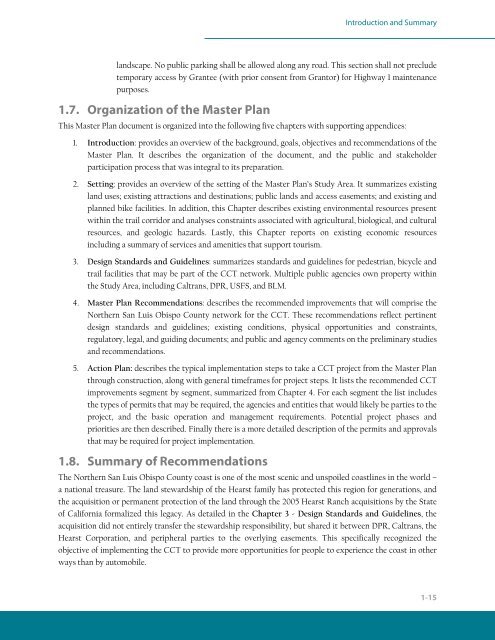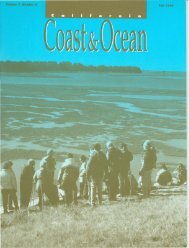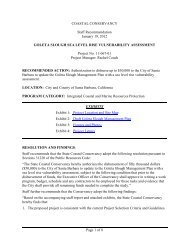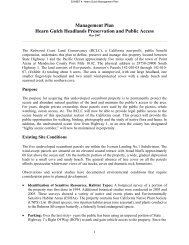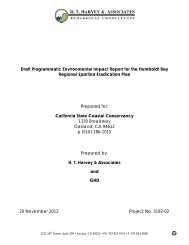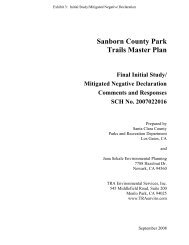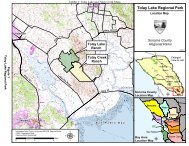Northern San Luis Obispo County Coastal Trail Master Plan
Northern San Luis Obispo County Coastal Trail Master Plan
Northern San Luis Obispo County Coastal Trail Master Plan
You also want an ePaper? Increase the reach of your titles
YUMPU automatically turns print PDFs into web optimized ePapers that Google loves.
Introduction and Summary<br />
landscape. No public parking shall be allowed along any road. This section shall not preclude<br />
temporary access by Grantee (with prior consent from Grantor) for Highway 1 maintenance<br />
purposes.<br />
1.7. Organization of the <strong>Master</strong> <strong>Plan</strong><br />
This <strong>Master</strong> <strong>Plan</strong> document is organized into the following five chapters with supporting appendices:<br />
1. Introduction: provides an overview of the background, goals, objectives and recommendations of the<br />
<strong>Master</strong> <strong>Plan</strong>. It describes the organization of the document, and the public and stakeholder<br />
participation process that was integral to its preparation.<br />
2. Setting: provides an overview of the setting of the <strong>Master</strong> <strong>Plan</strong>’s Study Area. It summarizes existing<br />
land uses; existing attractions and destinations; public lands and access easements; and existing and<br />
planned bike facilities. In addition, this Chapter describes existing environmental resources present<br />
within the trail corridor and analyses constraints associated with agricultural, biological, and cultural<br />
resources, and geologic hazards. Lastly, this Chapter reports on existing economic resources<br />
including a summary of services and amenities that support tourism.<br />
3. Design Standards and Guidelines: summarizes standards and guidelines for pedestrian, bicycle and<br />
trail facilities that may be part of the CCT network. Multiple public agencies own property within<br />
the Study Area, including Caltrans, DPR, USFS, and BLM.<br />
4. <strong>Master</strong> <strong>Plan</strong> Recommendations: describes the recommended improvements that will comprise the<br />
<strong>Northern</strong> <strong>San</strong> <strong>Luis</strong> <strong>Obispo</strong> <strong>County</strong> network for the CCT. These recommendations reflect pertinent<br />
design standards and guidelines; existing conditions, physical opportunities and constraints,<br />
regulatory, legal, and guiding documents; and public and agency comments on the preliminary studies<br />
and recommendations.<br />
5. Action <strong>Plan</strong>: describes the typical implementation steps to take a CCT project from the <strong>Master</strong> <strong>Plan</strong><br />
through construction, along with general timeframes for project steps. It lists the recommended CCT<br />
improvements segment by segment, summarized from Chapter 4. For each segment the list includes<br />
the types of permits that may be required, the agencies and entities that would likely be parties to the<br />
project, and the basic operation and management requirements. Potential project phases and<br />
priorities are then described. Finally there is a more detailed description of the permits and approvals<br />
that may be required for project implementation.<br />
1.8. Summary of Recommendations<br />
The <strong>Northern</strong> <strong>San</strong> <strong>Luis</strong> <strong>Obispo</strong> <strong>County</strong> coast is one of the most scenic and unspoiled coastlines in the world –<br />
a national treasure. The land stewardship of the Hearst family has protected this region for generations, and<br />
the acquisition or permanent protection of the land through the 2005 Hearst Ranch acquisitions by the State<br />
of California formalized this legacy. As detailed in the Chapter 3 - Design Standards and Guidelines, the<br />
acquisition did not entirely transfer the stewardship responsibility, but shared it between DPR, Caltrans, the<br />
Hearst Corporation, and peripheral parties to the overlying easements. This specifically recognized the<br />
objective of implementing the CCT to provide more opportunities for people to experience the coast in other<br />
ways than by automobile.<br />
1-15


